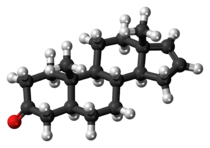안드로스테논
Androstenone | |
 | |
| 이름 | |
|---|---|
| 선호 IUPAC 이름 (3aS,3bR,5aS,9aS,9bS,11aR)-9a,11a-Dimethyl-3,3a,3b,4,5,5a,6,8,9,9a,9b,10,11,11a-tetradecahydro-7H-cyclopenta[a]phenanthren-7-one | |
| 기타 이름 5α-안드로스트-16-엔-3-1 | |
| 식별자 | |
3D 모델(JSmol) | |
| 체비 | |
| 켐벨 | |
| 켐스파이더 | |
| ECHA InfoCard | 100.038.367 |
펍켐 CID | |
| 유니 | |
CompTox 대시보드 (EPA) | |
| |
| |
| 특성. | |
| C19H28O | |
| 어금질량 | 272.432 g·190−1 |
달리 명시된 경우를 제외하고, 표준 상태(25°C [77°F], 100 kPa)의 재료에 대한 데이터가 제공된다. | |
| Infobox 참조 자료 | |
안드로스테논(5α-androst-16-en-3-1)은 스테로이드 페로몬이다. 멧돼지의 침, 셀러리 세포질,[citation needed] 트러플 균류에서 발견된다.[citation needed] 안드로스테논은 확인된 최초의 포유류 페로몬이었다. 수컷 돼지의 침에서 고농도로 발견되며, 열에 있는 암컷 돼지에 흡입되면 암컷이 짝짓기 자세를 취하게 된다. 안드로스테논은 양돈농가에 팔린 듀폰이 인공수정 시기를 시험하기 위해 양돈농가에 판매한 상업용 제품 '보아르메이트'의 활성 성분이다.[1][2][3][4][5]
생합성
안드로스테논은 안드로스테니오네에서 5α-저감효소로 합성되며, 3-케토스테노이드 환원효소에 의해 3α-안드로스테놀 또는 3β-안드로스테놀로 변환할 수 있다.[6]
특성.
대상에 따라 불쾌하고 땀에 젖은 요린 냄새, 나무 냄새, 심지어 기분 좋은 꽃향기까지 나는 것으로 보고되고 있다.[3][7][8]
한 개인이 냄새를 맡도록 하는 두 가지 다른 유전자형이 있다. 유전자의 완전한 기능을 가진 두 개의 복사본으로 구성된 첫 번째 유전자형은 RT/RT 알레일이고, 두 번째는 RT/WM 알레일이다.[citation needed] OR7D4 수용체에는[4] 두 개의 비동기식 단일 뉴클레오티드 다형성([9]non-synamic single nucleotide polymorism)이 있어 유전자는 두 개의 아미노산 대체물을 갖게 되고, 이는 다시 수용체가 다르게 작용하게 된다. OR7D4용 RT/RT라는 두 개의 적절한 유전자를 소유하고 있는 사람들은 스테로이드의 냄새를 퀴퀴한 소변의 냄새로 묘사하는 경향이 있다. 오직 하나의 유전자(RT/WM)만을 가진 사람들은 일반적으로 그 냄새를 약하거나 그것을 감지할 수 없다고 묘사했다. 그들은 또한 '기분 좋다', '달다', '바닐라와 비슷하다'[10]는 냄새를 찾을 수 있다.
소량으로는 대부분의 사람들이 그 냄새를 거의 감지할 수 없다. 이는 안드로스테논 수용체를 암호화하는 수용체 유전자의 다형성 때문일 수 있다.[11] 그러나 냄새를 감지하는 능력은 크게 다르다. 이 악취는 1억분의 1억분의 1에서 0.2ppm 수준으로 내려가는 사람들에게서 검출될 수 있는 것으로 나타났다.[12] 그러나 몇몇 단체들은 처음에 냄새를 맡지 못하는 몇몇 개인은 반복적으로 그것에 노출됨으로써 냄새를 맡는 법을 배울 수 있다고 보고한다.[13]
페로몬으로서의 검출성
인간에게도 안드로스테논은 페로몬이라고 제안되어 왔지만, 이러한 주장을 뒷받침할 과학적인 자료는 거의 없다.[14] vomeronasal organ은 페로몬을 단순한 냄새 이상의 것으로서 검출하는 것을 담당하는 보조 후각 감각 기관이다. 대부분의 성인 인간은 이 장기와 비슷한 것을 가지고 있지만, 활동적인 기능은 없다. 인간은 냄새를 넘어 페로몬을 검출하는 데 필요한 다른 포유류에 존재하는 감각 세포가 부족하다. 인간은 또한 이러한 감각세포를 능동적으로 생산하는 유전적 능력이 부족하다.[citation needed]
또한 어떤 인간에게는 냄새에 특정한 음독증이 있다; 그들은 특정한 냄새를 맡을 수 없지만, 그렇지 않으면 정상적인 후각을 가지고 있다. 그러나 이것은 80개 이상의 후각 화합물에서 사실이기 때문에 결코 페로몬으로 분류되는 것으로 보아서는 안 된다.[15]
동물들에게 안드로스테논의 냄새는 지배의 사회적 신호로 작용할 수도 있고, 짝을 끌어들이는 방법이 될 수도 있다.
상업용
시중에서 판매되는 일부 제품은 안드로스테논을 포함한 인간의 성적인 페로몬이 함유돼 있고, 진통제 역할을 할 수 있다는 주장을 이용해 광고하고 있다. 이 제품들은 대량으로 요청되지 않은 이메일에 의한 마케팅의 대상이다.
참고 항목
참조
- ^ Pierce, John D.; Cohen, Adam B.; Ulrich, Patricia M. (March 2004). "Responsivity to Two Odorants, Androstenone and Amyl Acetate, and the Affective Impact of Odors on Interpersonal Relationships". Journal of Comparative Psychology. 118 (1): 14–19. doi:10.1037/0735-7036.118.1.14. PMID 15008668.
- ^ Dorries, Kathleen M.; Adkins-Regan, Elizabeth; Halpern, Bruce P. (1997). "Sensitivity and Behavioral Responses to the Pheromone Androstenone Are Not Mediated by the Vomeronasal Organ in Domestic Pigs". Brain, Behavior and Evolution. 49 (1): 53–62. doi:10.1159/000112981. PMID 8980852.
- ^ a b Wysocki, C. J.; Dorries, K. M.; Beauchamp, G. K. (1 October 1989). "Ability to perceive androstenone can be acquired by ostensibly anosmic people". Proceedings of the National Academy of Sciences. 86 (20): 7976–7978. Bibcode:1989PNAS...86.7976W. doi:10.1073/pnas.86.20.7976. PMC 298195. PMID 2813372.
- ^ a b Wysocki, C. J.; Beauchamp, G. K. (1 August 1984). "Ability to smell androstenone is genetically determined". Proceedings of the National Academy of Sciences. 81 (15): 4899–4902. Bibcode:1984PNAS...81.4899W. doi:10.1073/pnas.81.15.4899. PMC 391599. PMID 6589634.
- ^ Bonneau, M.; Walstra, P.; Claudi-Magnussen, C.; Kempster, A.J.; Tornberg, E.; Fischer, K.; Diestre, A.; Siret, F.; Chevillon, P.; Claus, R.; Dijksterhuis, G.; Punter, P.; Matthews, K.R.; Agerhem, H.; Béague, M.P.; Oliver, M.A.; Gispert, M.; Weiler, U.; von Seth, G.; Leask, H.; Font i Furnols, M.; Homer, D.B.; Cook, G.L. (March 2000). "An international study on the importance of androstenone and skatole for boar taint: IV. Simulation studies on consumer dissatisfaction with entire male pork and the effect of sorting carcasses on the slaughter line, main conclusions and recommendations". Meat Science. 54 (3): 285–295. doi:10.1016/s0309-1740(99)00105-9. PMID 22060698.
- ^ Weusten, J. J. A. M. (1989). Biochemical pathways in human testicular steroidogenesis (Thesis). hdl:2066/113615.
- ^ "Sniffers' genes dictate if sweat smells sweet". New Scientist. 19 September 2007.
- ^ Steenhuysen, Julie (16 September 2007). "Stinky? It's not his sweat, it's your nose". Reuters.
- ^ Keller, Andreas; Zhuang, Hanyi; Chi, Qiuyi; Vosshall, Leslie B.; Matsunami, Hiroaki (September 2007). "Genetic variation in a human odorant receptor alters odour perception". Nature. 449 (7161): 468–472. Bibcode:2007Natur.449..468K. doi:10.1038/nature06162. PMID 17873857. S2CID 4417235. Lay summary.
- ^ Swaminathan, Nikhil (18 September 2007). "The Scent of a Man". Scientific American.
- ^ Lundstrom, J. N.; Seven, S.; Olsson, M. J.; Schaal, B.; Hummel, T. (1 October 2006). "Olfactory Event-Related Potentials Reflect Individual Differences in Odor Valence Perception". Chemical Senses. 31 (8): 705–711. doi:10.1093/chemse/bjl012. PMID 16844768.
- ^ Birchall, Annabelle (25 August 1990). "A whiff of happiness: Can smelling a molecule contained in human sweat ease anxiety and stress? Some scientists think so, and argue that 'osmotherapy' may also help people to slim or stop smoking". New Scientist.
- ^ Graham, Sarah (23 October 2002). "Nostrils Share Information for Recognizing Scents". Scientific American.
- ^ Kirk-Smith, M.D.; Booth, D.A. (1980). "Effect of androstenone on choice of location in others' presence". In van der Starre, H (ed.). Proceedings of the 7th International Symposium on Olfaction and Taste (ISOT VII) and of the 4th Congress of the European Chemoreception Research Organization (ECRO IV): joint meeting held at 'de Leeuwenhorst' Congress Centre, Noordwijkerhout, the Netherlands, 22nd-25th July, 1980. IRL Press. pp. 397–400. ISBN 978-0-904147-20-9. OCLC 63367504.CS1 maint: 날짜 및 연도(링크)
- ^ Araneda, Ricardo C.; Firestein, Stuart (1 January 2004). "The scents of androstenone in humans". The Journal of Physiology. 554 (1): 1. doi:10.1113/jphysiol.2003.057075. PMC 1664751. PMID 14678483.


